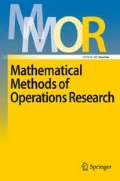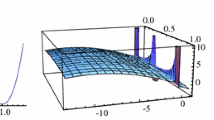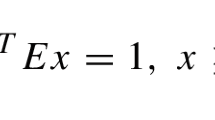Abstract
This paper presents a set of complete solutions and optimality conditions for a nonconvex quadratic-exponential optimization problem. By using the canonical duality theory developed by the first author, the nonconvex primal problem in n-dimensional space can be converted into an one-dimensional canonical dual problem with zero duality gap, which can be solved easily to obtain all dual solutions. Each dual solution leads to a primal solution. Both global and local extremality conditions of these primal solutions can be identified by the triality theory associated with the canonical duality theory. Several examples are illustrated.
Similar content being viewed by others
References
Briggs GE, Kidd FA and West C (1920). A quantitative analysis of plant growth. Ann Appl Biol 7: 202–223
Ekeland I, Gao DY (2007) Unified canonical duality solutions to a class of nonconvex optimization problems (to appear)
Fang SC, Gao DY, Sheu RL and Wu SY (2007). Canonical duality and complete solution to nonconvex integer programming problems. J Indust Manag Optim 4(1): 125–142
Fang S-C, Gao DY, Sheu R-L, Xin WX (2007b) Global optimization for a class of fractional programming problems. J Glob Optim (submitted)
Floudas CA (2000). Deterministic Global Optimization: theory, methods and applications. Kluwer Academic, Dordrecht
Floudas CA (2003) Systems approaches in bioinformatics and computational genomics, Challenges for the Chemical Sciences in the 21th Century, Information and Communications Workshop, National Research Council of the National Academies, National Academies Press, pp 116–125
Gao DY (1998). Duality, triality and complementary extremun principles in nonconvex parametric variational problems with applications. IMA J Appl Math 61: 199–235
Gao DY (2000a). Duality principles in nonconvex systems: theory, methods and applications, vol 18. Kluwer Academic, Dordrecht, 454 pp
Gao DY (2000b). Canonical dual transformation method and generalized triality theory in nonsmooth global optimization. J Glob Optim 17(1/4): 127–160
Gao DY (2000c). Analytic solution and triality theory for nonconvex and nonsmooth vatiational problems with applicatons. Nonlinear Anal 42(7): 1161–1193
Gao DY (2003). Nonconvex semi-linear problems and canonical dual solutions. In: Gao, DY and Ogden, RW (eds) Advances in mechanics and mathematics, vol 2, pp 261–312. Kluwer Academic, Dordrecht
Gao DY (2003b). Perfect duality theory and complete solutions to a class of global optimization problems. Optim 52(4–5): 467–493
Gao DY (2004). Canonical duality theory and solutions to constrained nonconvex quadratic programming. J Glob Optim 29: 377–399
Gao DY (2005). Sufficient conditions and perfect duality in nonconvex minimization with inequality constraints. J Ind Manage Optim 1: 59–69
Gao DY (2006). Complete solutions and extremality criteria to polynomial optimization problems. J Glob Optim 35: 131–143
Gao DY, Ruan N, Sherali HD (2007) Solutions and optimality criteria for nonconvex constrained global optimization problems. J Glob Optim (in press)
Gao DY, Ogden RW (2007) Closed-form solutions, extremality and nonsmoothness criteria in a large deformation elasticity problem. Z Math Phys (in press)
Gao DY, Sherali HD (2007) Canonical duality theory: connection between nonconvex mechanics and global optimization. In: Advances in mechanics and mathematics, vol 3. Springer, Heidelberg
Gao DY and Strang G (1989). Geometric nonlinearity: potential energy, complementary energy and the gap function. Quart Appl Math 47(3): 487–504
Gao DY (2007). Solutions and optimality to box constrained nonconvex minimization problem. J Ind Manage Optim 3(2): 293–304
Han CG, Pardalos PM, Ye Y (1990) An interior point algorithm for large-scale quadratic problems with box constraints. In: Bensoussan A, Lions JL (eds) In: Springer-Verlag lecture notes in control and information, vol 144, pp 413–422
Hansen P, Jaumard B, Ruiz M, Xiong J(1991) Global minimization of indefinite quadratic functions subjects to box constraints. Technical report, Technical Report G-91-54, Gread, École Polytechnique, Université McGill, Montreal
Holzapfel GA, Ogden RW (eds) (2006). Mechanics of biological tissue, vol 12. Springer, Heidelberg, 522 pp
Horst R, Pardalos PM and Thoai NV (2000). Introduction to global optimization. Kluwer Academic, Dordrecht
(2006). On dual configuration forces. J Elasticity 84: 13–31
Wang Z, Fang S-C, Gao DY, Xin WX (2008) Global extremal conditions for multi-integer quadratic programming. J Ind Manage Optim 4 (in press)
Author information
Authors and Affiliations
Corresponding author
Rights and permissions
About this article
Cite this article
Gao, D.Y., Ruan, N. Solutions and optimality criteria for nonconvex quadratic-exponential minimization problem. Math Meth Oper Res 67, 479–491 (2008). https://doi.org/10.1007/s00186-007-0204-7
Published:
Issue Date:
DOI: https://doi.org/10.1007/s00186-007-0204-7




